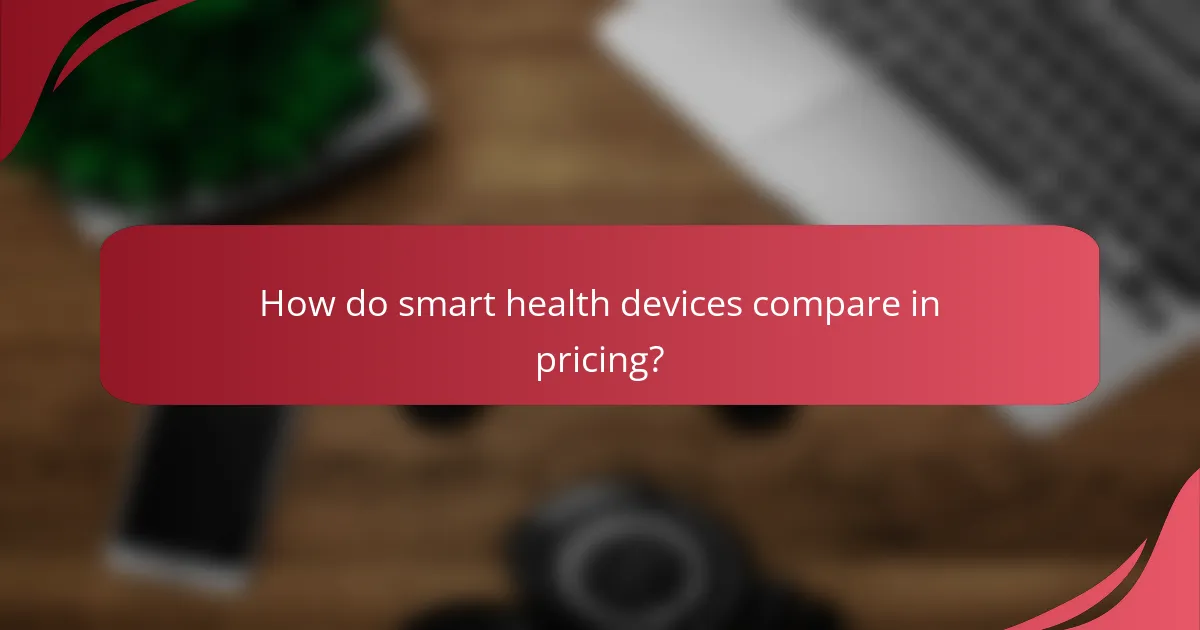Smart health and fitness devices have revolutionized diabetes management, offering tools such as Continuous Glucose Monitors (CGMs), smart insulin pens, and diabetes management apps. These innovative devices provide real-time tracking of glucose levels and insulin delivery, empowering users to maintain healthier lifestyles. By focusing on accuracy, usability, and connectivity, these tools facilitate informed health decisions and enhance overall management of diabetes.

What are the best smart health devices for diabetes management?
The best smart health devices for diabetes management include Continuous Glucose Monitors (CGMs), smart insulin pens, diabetes management apps, wearable fitness trackers, and smart blood glucose meters. These tools help individuals track their glucose levels, manage insulin delivery, and maintain a healthier lifestyle.
Continuous Glucose Monitors (CGMs)
Continuous Glucose Monitors (CGMs) provide real-time glucose readings throughout the day and night. These devices use a small sensor inserted under the skin to measure glucose levels in interstitial fluid, sending data to a smartphone or receiver.
CGMs can significantly improve diabetes management by alerting users to high or low glucose levels, allowing for timely interventions. Popular options include the Dexcom G6 and the FreeStyle Libre, which offer features like trend analysis and customizable alerts.
Smart Insulin Pens
Smart insulin pens are designed to help users administer insulin more effectively by tracking doses and timing. These pens often connect to mobile apps, allowing users to log their insulin intake and receive reminders for their next doses.
Some smart pens, like the InPen, provide dosage recommendations based on current glucose levels and carbohydrate intake, enhancing overall management. Users should consider compatibility with their insulin type and whether the pen can store historical data for better tracking.
Diabetes Management Apps
Diabetes management apps serve as comprehensive tools for tracking glucose levels, medication, diet, and exercise. These apps can sync with other devices like CGMs and smart insulin pens, providing a holistic view of an individual’s health.
Popular apps such as MySugr and Glucose Buddy offer features like food logging, activity tracking, and personalized insights. Users should look for apps that are user-friendly and compatible with their existing devices for seamless integration.
Wearable Fitness Trackers
Wearable fitness trackers monitor physical activity, heart rate, and sleep patterns, which are crucial for diabetes management. Devices like Fitbit and Garmin can help users set fitness goals and track their progress over time.
These trackers often include features that allow users to log their workouts and monitor how exercise affects their glucose levels. It’s essential to choose a tracker that fits comfortably and has a long battery life for continuous use.
Smart Blood Glucose Meters
Smart blood glucose meters provide accurate readings of blood sugar levels and often connect to smartphones for easy data management. These devices typically require a small blood sample and can deliver results in seconds.
Models like the Accu-Chek Guide and OneTouch Verio Flex offer Bluetooth connectivity, allowing users to track their readings over time and share data with healthcare providers. When selecting a meter, consider factors like ease of use, test strip cost, and data-sharing capabilities.

How do smart health devices improve diabetes management?
Smart health devices enhance diabetes management by providing continuous monitoring, data integration, and personalized insights. These tools enable users to track their glucose levels in real-time, making it easier to manage their condition effectively.
Real-time glucose monitoring
Real-time glucose monitoring allows individuals with diabetes to track their blood sugar levels continuously throughout the day. Devices such as continuous glucose monitors (CGMs) provide readings every few minutes, helping users identify trends and make timely adjustments to their diet or medication.
These devices can alert users when their glucose levels are too high or too low, which is crucial for preventing complications. Many CGMs are designed to be worn on the body for extended periods, offering convenience and reducing the need for frequent finger pricks.
Data integration with health apps
Smart health devices often integrate seamlessly with health apps, allowing users to consolidate their health data in one place. This integration can include glucose readings, food intake, exercise, and medication schedules, providing a comprehensive view of diabetes management.
Many apps can generate reports or visualizations that help users understand their patterns over time. This data can also be shared with healthcare providers, facilitating more informed discussions during medical appointments.
Personalized insights and alerts
Personalized insights generated by smart health devices can help users understand how different foods, activities, and medications affect their glucose levels. By analyzing trends, these devices can offer tailored recommendations for lifestyle adjustments.
Alerts can be set up for specific thresholds, notifying users when their glucose levels require immediate attention. This proactive approach empowers individuals to take control of their health and make informed decisions about their diabetes management.

What features should you look for in diabetes management tools?
When selecting diabetes management tools, prioritize features that enhance accuracy, usability, and connectivity. These elements are crucial for effective monitoring and management of blood sugar levels, ensuring you can make informed health decisions.
Accuracy and reliability
Accuracy is paramount in diabetes management tools, as even small errors can lead to significant health risks. Look for devices that meet recognized standards, such as ISO 15197, which ensures blood glucose meters provide reliable readings within a specified range.
Many reputable brands offer devices that boast accuracy rates above 95%. Regular calibration and maintenance can further enhance reliability, so consider tools that allow for easy recalibration.
Ease of use
Ease of use is essential for consistent diabetes management. Choose devices with intuitive interfaces, clear displays, and straightforward navigation to minimize the learning curve. Features like one-touch operation or voice commands can significantly enhance usability.
Consider the size and portability of the device as well. Compact tools that fit easily in your pocket or bag encourage regular use, which is vital for effective diabetes management.
Compatibility with other devices
Compatibility with other devices is a key feature to enhance your diabetes management experience. Look for tools that can sync with smartphones, tablets, or computers, allowing for seamless data tracking and analysis.
Integration with health apps can provide additional insights and trends, making it easier to manage your condition. Ensure the device supports popular platforms like iOS and Android for broader compatibility.
Data sharing capabilities
Data sharing capabilities enable you to share your health information with healthcare providers or family members, facilitating better support and management. Choose devices that offer secure sharing options, such as cloud storage or direct sharing via apps.
Some tools allow for real-time data sharing, which can be particularly beneficial during medical appointments or emergencies. Ensure that the device complies with privacy regulations to protect your personal health information.

What are the benefits of using smart health devices for diabetes?
Smart health devices for diabetes offer significant advantages, including better blood sugar management, improved lifestyle choices, and a lower risk of complications. These tools empower users to monitor their condition more effectively and make informed decisions about their health.
Improved blood sugar control
Smart health devices, such as continuous glucose monitors (CGMs) and insulin pumps, provide real-time data on blood sugar levels. This immediate feedback allows users to adjust their diet, exercise, and medication promptly, leading to more stable glucose levels.
Many devices can send alerts when blood sugar levels are too high or too low, helping users take action before serious issues arise. For example, a CGM might notify a user to consume carbohydrates if their levels drop below a certain threshold.
Enhanced lifestyle management
Smart devices help users integrate diabetes management into their daily routines seamlessly. Many applications sync with fitness trackers, allowing individuals to monitor their physical activity and its impact on blood sugar levels.
By analyzing patterns over time, users can identify which foods or activities affect their glucose levels most significantly. This insight enables better meal planning and exercise regimens tailored to individual needs, promoting a healthier lifestyle overall.
Reduced risk of complications
Consistent monitoring and management of diabetes through smart devices can significantly lower the risk of long-term complications, such as cardiovascular disease, neuropathy, and retinopathy. By maintaining optimal blood sugar levels, users can protect their overall health.
Additionally, many smart devices offer educational resources and reminders for regular check-ups, ensuring users stay on top of their health care needs. This proactive approach can lead to early detection and treatment of potential issues, further reducing risks associated with diabetes.

How do smart health devices compare in pricing?
Smart health devices vary widely in pricing, influenced by features, brand, and technology. For diabetes management tools, costs can range from affordable basic models to high-end continuous glucose monitors (CGMs) with advanced functionalities.
Cost of Continuous Glucose Monitors
Continuous glucose monitors typically range from several hundred to over a thousand USD, depending on the model and features. Basic CGMs may start around 300 USD, while advanced systems with integrated apps and real-time data sharing can exceed 1,000 USD.
When considering the cost of CGMs, it’s essential to factor in additional expenses such as sensors, which often require replacement every few weeks. Insurance coverage can significantly affect out-of-pocket costs, so checking with your provider is advisable.
Some popular CGM brands include Dexcom and Abbott Freestyle, each offering different pricing structures and subscription models. It’s beneficial to compare these options based on your specific needs and budget to find the best fit for effective diabetes management.

